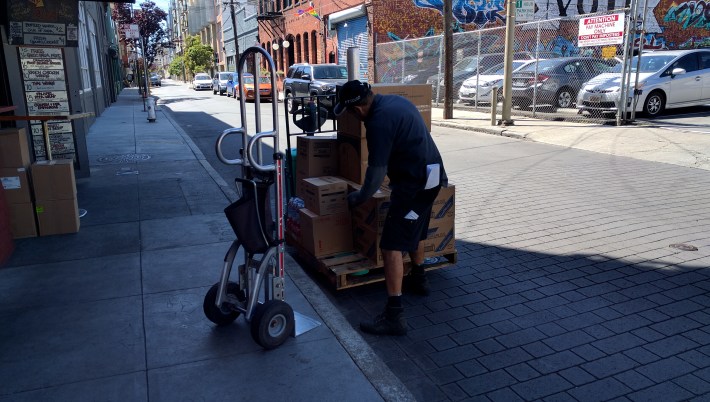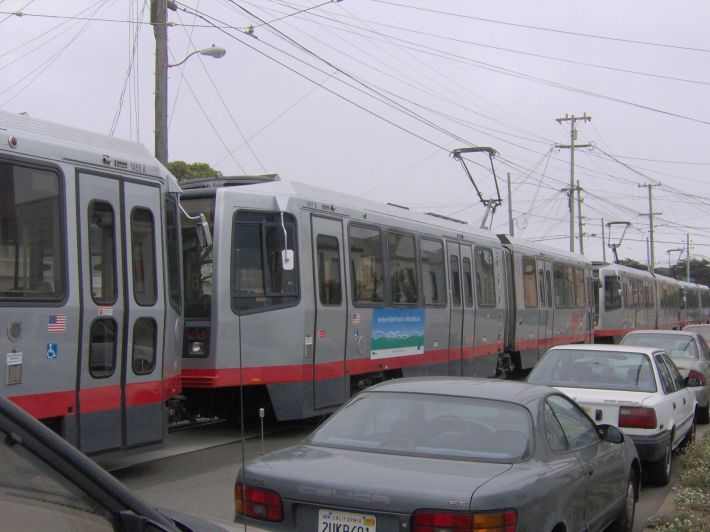
Marco Salsiccia is a blind resident of the Sunset District. Last month, while stepping off an L-Taraval train at a stop without a boarding island, he got his cane stuck in the wheel well of a car as it illegally passed the train. His cane snapped in two. The motorist stopped briefly and then took off. Salsiccia emailed his San Francisco Supervisor Katy Tang about the incident:
Today's situation could easily have been much worse. I could have been injured, maimed, or even killed. If this happened to me, I imagine similar—if not worse—things have occurred to others in the highly-trafficked area.
Indeed, worse things have happened. Salsiccia had his foot run over by a driver a few years earlier while he crossed Taraval from Safeway (fortunately, he only suffered some bruising). As Streetsblog previously reported, SFMTA data shows that 22 people have been hit getting off trains on Taraval just in the past five years.
Streetsblog reached out to Tang's office to get her take on the rate of improvements on Taraval under SFMTA's Muni Forward program. Streetsblog will update this post if a reply is received. But this was part of her reply to Salsiccia's email:
Please know that there is currently an intensive planning process happening to plan for future safety improvements along the L-Taraval, including proposals for boarding islands. Along with that have been other ideas for how we can properly train/educate drivers about slowing down near trains where passengers are getting on/off the trains, and stopping behind the train when this occurs.
If that seems a bit wishy washy, there's a reason. As previously reported, there's resistance to boarding islands because they require taking away (or relocating) street parking. And this gets local merchants up in arms.
But as Nicole Ferrara, Executive Director of Walk SF, said in a previous interview with Streetsblog, boarding islands shouldn't even be a conversation--they should just get done, adding that politicians "all need to be pushing for the safest treatments possible. Vision Zero is not about compromising; it’s about doing the safest things and figuring out the rest later."
That begs a larger question. Where did this assumption come from in the first place that the city is obligated to provide free, or almost free, car storage all over the city for private automobiles? In fact, didn't the voters make it clear they do not want the city doing that anymore? A release this week from SFMTA sums it up well:
San Francisco is in the midst of one of its biggest new-housing construction booms in history, projected to add 100,000 households and more than 190,000 new jobs by 2040. If everyone arrives with a car, that’s going to be a recipe for gridlock and economic stagnation. The effects on the environment, quality of life and pedestrian safety will be substantial. The city will grind to a halt.
And, as with road widening, providing on-street car storage for everyone is just going to lead to more gridlock:
The growing research on the link between available parking and people’s decision to drive is part of the data the SFMTA, Planning Department, and San Francisco County Transportation Authority are considering as they work on legislation that will help shape future development in the city and provide incentives for people to get around without relying on driving alone in a car.
The SFMTA piece makes a strong case: the more road space for cars and more free parking just induces more car trips, which uses up the parking, and results in more gridlock--and less movement of people. There's only so much space on our streets. Providing parking for the sake of nearby businesses means less room for protected bike paths, transit-only lanes, wider sidewalks, street trees, boarding islands and safety buffers generally. And by creating more gridlock, free parking reduces the number of people who can access local businesses. The businesses, in the long run, get more patrons in their shops by making it easier to walk, bike and take transit.
"I think people are going to be resistant to change no matter what. They do something, they think it’s the best way it can be; merchants say business suffers if parking is moved around the corner," said Ferrara. "In fact it’s just the opposite. You create more transit-rich places for people to walk and bike and local businesses thrive."
"Did anyone ever tell them that foot traffic to their stores would increase if people are walking by instead of driving by?" asked Salsiccia. But businesses, meanwhile, don't buy it, and are convinced eliminating or greatly reducing parking will destroy them. But studies show they're just wrong. Moreover, the busiest, most vibrant, most economically vital streets in the world have no street parking. Take London's Oxford Street, or Kalverstraat in Amsterdam, or go no further than stretches of Powell and Market that have severe limitations, albeit often unenforced or watered down, on through traffic and street parking. If the businesses on Mission or Taraval are convinced that reduced parking kills their bottom line, then they need to provide hard evidence.
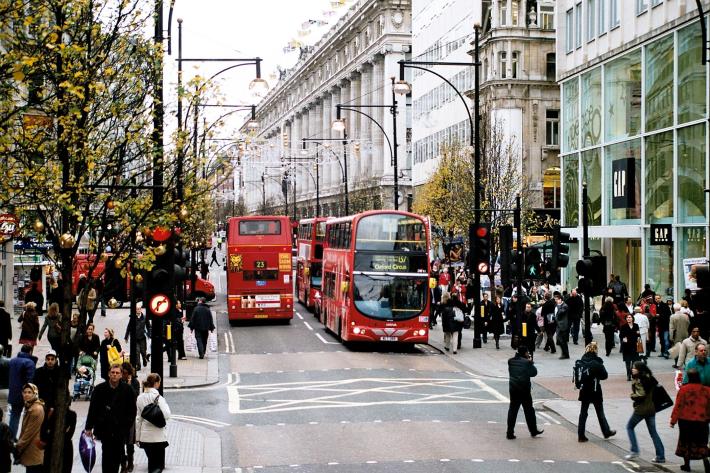
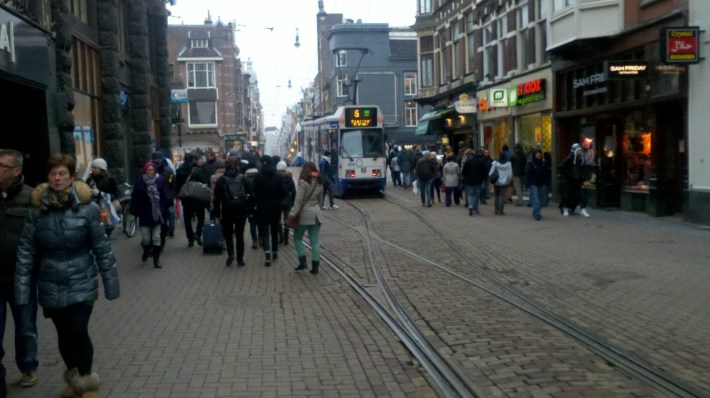
What about deliveries? Certainly, this has to be dealt with. As reported previously, Mission, with its new transit-only lanes, still has loading areas reserved for merchants. And on some of San Francisco's oldest, narrowest streets delivery truck drivers manage, such as this one who is delivering beer to a bar on Natoma Street--he left his truck parked legally around the corner.
Still, parking preservation seems to be the main political impediment for major transit and safety improvements. It's even got the occasional transit advocates convinced that there isn't enough room for bike lanes. When anyone says "There isn't enough room for bike lanes/boarding islands/transit-only lanes" one has to unpack that statement. They're really saying: "every street must have parking." Which, if anyone does the math on it, is an incredibly inefficient use of space. Just look at this photo from SFMTA and the massive amount of invaluable San Francisco real estate being used by some 20 parked automobiles which are stationary 95 percent of the time and carry fewer people than a single, 126-year-old cable car.
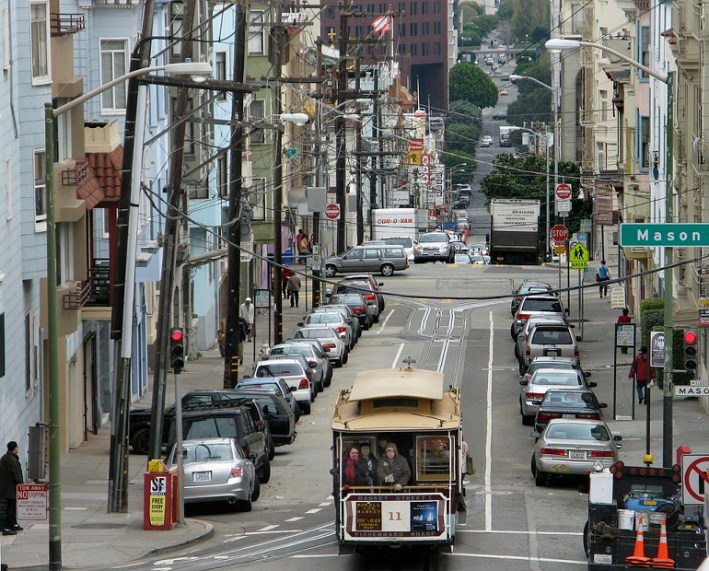
It doesn't mean all parking should be eliminated everywhere. But in dense corridors parking can be shifted to side streets as perpendicular parking, as is being done with several SFMTA street improvement projects. Or perhaps it's time to encourage narrow, multistory, for-profit parking storage, using parking elevators to store many cars on a small footprint, with rates driven by demand. Of course, that means car storage will actually become too expensive for most drivers. But that's better than the entire society bearing all the costs and associated dangers.
While the photographic evidence and the studies seem to make it obvious that trading transit and safety for car storage is counter productive, the real failure, said Ferrara, is lack of leadership. "We need our politicians to step up and say 'your business will not suffer.' Meanwhile, people are dying."
Salsiccia agreed and said the issue on Taraval is clear and that painted safety zones aren't enough. "There should be lots more if not all boarding islands to make it safer and easier for everyone to get off the train," he said. "Life and limb is more important than the merchants and their parking spots."
